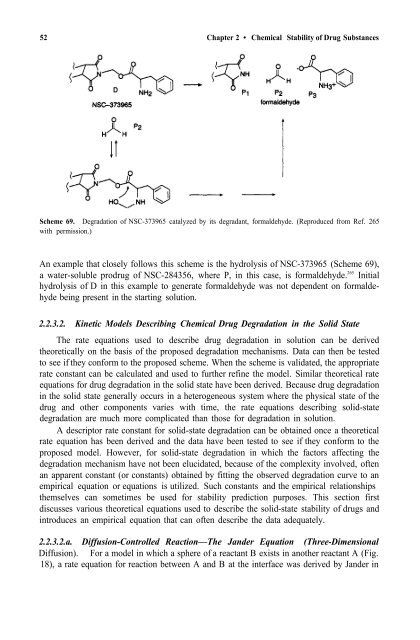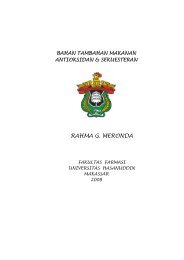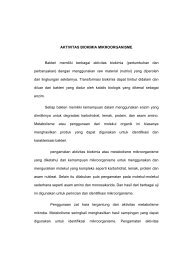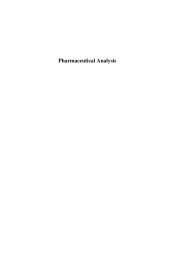- Page 2 and 3:
Stability of Drugs and Dosage Forms
- Page 4 and 5:
eBook ISBN: 0-306-46829-8 Print ISB
- Page 6 and 7:
vi Preface As stated earlier, this
- Page 8 and 9:
viii Contents 2.2.4.2. Quantitation
- Page 10 and 11: x Contents 5.1.1.3. Hydrolysis ....
- Page 12 and 13: Chapter 2 Chemical Stability of Dru
- Page 14 and 15: 2.1. • Pathways of Chemical Degra
- Page 16 and 17: 2.1. • Pathways of Chemical Degra
- Page 18 and 19: 2.1. • Pathways of Chemical Degra
- Page 20 and 21: 2.1. • Pathways of Chemical Degra
- Page 22 and 23: 2.1. • Pathways of Chemical Degra
- Page 24 and 25: 2.1. • Pathways of Chemical Degra
- Page 26 and 27: 2.1. • Pathways of Chemical Degra
- Page 28 and 29: 2.1. • Pathways of Chemical Degra
- Page 30 and 31: 2.1. • Pathways of Chemical Degra
- Page 32 and 33: 2.1. • Pathways of Chemical Degra
- Page 34 and 35: 2.1. • Pathways of Chemical Degra
- Page 36 and 37: 2.1. • Pathways of Chemical Degra
- Page 38 and 39: 2.1. • Pathways of Chemical Degra
- Page 40 and 41: 2.1. • Pathways of Chemical Degra
- Page 42 and 43: 2.1. • Pathways of Chemical Degra
- Page 44 and 45: 2.2. • Factors Affecting Chemical
- Page 46 and 47: 2.2. • Factors Affecting Chemical
- Page 48 and 49: 2.2. • Factors Affecting Chemical
- Page 50 and 51: 2.2. • Factors Affecting Chemical
- Page 52 and 53: 2.2. • Factors Affecting Chemical
- Page 54 and 55: 2.2. • Factors Affecting Chemical
- Page 56 and 57: 2.2. • Factors Affecting Chemical
- Page 58 and 59: 2.2. • Factors Affecting Chemical
- Page 62 and 63: 2.2. • Factors Affecting Chemical
- Page 64 and 65: 2.2. • Factors Affecting Chemical
- Page 66 and 67: 2.2. • Factors Affecting Chemical
- Page 68 and 69: 2.2. • Factors Affecting Chemical
- Page 70 and 71: 2.2. • Factors Affecting Chemical
- Page 72 and 73: 2.2. • Factors Affecting Chemical
- Page 74 and 75: 2.2. • Factors Affecting Chemical
- Page 76 and 77: 2.2. • Factors Affecting Chemical
- Page 78 and 79: 2.2. • Factors Affecting Chemical
- Page 80 and 81: 2.2. • Factors Affecting Chemical
- Page 82 and 83: 2.2. • Factors Affecting Chemical
- Page 84 and 85: 2.2. • Factors Affecting Chemical
- Page 86 and 87: 2.2. • Factors Affecting Chemical
- Page 88 and 89: 2.2. • Factors Affecting Chemical
- Page 90 and 91: 2.2. • Factors Affecting Chemical
- Page 92 and 93: 2.2. • Factors Affecting Chemical
- Page 94 and 95: 2.2. • Factors Affecting Chemical
- Page 96 and 97: 2.2. • Factors Affecting Chemical
- Page 98 and 99: 2.2. • Factors Affecting Chemical
- Page 100 and 101: 2.2. • Factors Affecting Chemical
- Page 102 and 103: 2.2. • Factors Affecting Chemical
- Page 104 and 105: 2.2. • Factors Affecting Chemical
- Page 106 and 107: 2.2. • Factors Affecting Chemical
- Page 108 and 109: 2.2. • Factors Affecting Chemical
- Page 110 and 111:
2.2. • Factors Affecting Chemical
- Page 112 and 113:
2.2. • Factors Affecting Chemical
- Page 114 and 115:
2.2. • Factors Affecting Chemical
- Page 116 and 117:
2.2. • Factors Meeting Chemical S
- Page 118 and 119:
2.2. • Factors Affecting Chemical
- Page 120 and 121:
2.2. • Factors Affecting Chemical
- Page 122 and 123:
2.2. • Factors Affecting Chemical
- Page 124 and 125:
2.2. • Factors Affecting Chemical
- Page 126 and 127:
2.2. • Factors Affecting Chemical
- Page 128 and 129:
2.2. • Factors Affecting Chemical
- Page 130 and 131:
2.2. • Factors Affecting Chemical
- Page 132 and 133:
2.2. • Factors Affecting Chemical
- Page 134 and 135:
23. • Stabilization of Drug Subst
- Page 136 and 137:
2.3. • Stabilization of Drug Subs
- Page 138 and 139:
2.3. • Stabilization of Drug Subs
- Page 140 and 141:
2.3. • Stabilization of Drug Subs
- Page 142 and 143:
23. • Stabilization of Drug Subst
- Page 144 and 145:
2.3. • Stabilization of Drug Subs
- Page 146 and 147:
2.3. • Stabilization of Drug Subs
- Page 148 and 149:
140 Chapter 3 • Physical Stabilit
- Page 150 and 151:
142 Chapter 3 • Physical Stabilit
- Page 152 and 153:
144 Chapter 3 • Physical Stabilit
- Page 154 and 155:
146 Chapter 3 • Physical Stabilit
- Page 156 and 157:
148 Chapter 3 • Physical Stabilit
- Page 158 and 159:
150 Chapter 3 • Physical Stabilit
- Page 160 and 161:
152 Chapter 4 • Stability of Dosa
- Page 162 and 163:
154 Chapter 4 • Stability of Dosa
- Page 164 and 165:
156 Chapter 4 • Stability of Dosa
- Page 166 and 167:
158 Chapter 4 • Stability of Dosa
- Page 168 and 169:
160 Chapter 4 • Stability of Dosa
- Page 170 and 171:
162 Chapter 4 • Stability of Dosa
- Page 172 and 173:
164 Chapter 4 • Stability of Dosa
- Page 174 and 175:
166 Chapter 4 • Stability of Dosa
- Page 176 and 177:
168 Chapter 4 • Stability of Dosa
- Page 178 and 179:
170 Chapter 4 • Stability of Dosa
- Page 180 and 181:
172 Chapter 4 • Stability of Dosa
- Page 182 and 183:
174 Chapter 4 • Stability of Dosa
- Page 184 and 185:
176 Chapter 4 • Stability of Dosa
- Page 186 and 187:
178 Chapter 4 • Stability of Dosa
- Page 188 and 189:
180 Chapter 4 • Stability of Dosa
- Page 190 and 191:
182 Chapter 4 • Stability of Dosa
- Page 192 and 193:
184 Chapter 4 • Stability of Dosa
- Page 194 and 195:
186 Chapter 4 • Stability of Dosa
- Page 196 and 197:
188 Chapter 5 • Stability of Pept
- Page 198 and 199:
190 Chapter 5 • Stability of Pept
- Page 200 and 201:
192 Chapter 5 • Stability of Pept
- Page 202 and 203:
194 Chapter 5 • Stability of Pept
- Page 204 and 205:
196 Chapter 5 • Stability of Pept
- Page 206 and 207:
198 Chapter 5 • Stability of Pept
- Page 208 and 209:
200 Chapter 5 • Stability of Pept
- Page 210 and 211:
202 Chapter 5 • Stability of Pept
- Page 212 and 213:
Chapter 6 Regulations The efficacy
- Page 214 and 215:
6.1. • ICH Harmonised Tripartite
- Page 216 and 217:
6.1. • ICH Harmonised Mpartite Gu
- Page 218 and 219:
6.1. • ICH Harmonised Trpartite G
- Page 220 and 221:
6.1. • ICH Harmonised Tripartite
- Page 222 and 223:
6.1. • ICH Harmonised Tripartite
- Page 224 and 225:
6.2 • ICH Harmonised Tripartite G
- Page 226 and 227:
6.2 • ICH Harmonised Tripartite G
- Page 228 and 229:
6.2 • ICH Harmonised Tripartite G
- Page 230 and 231:
5. • Major Concerns Raised by the
- Page 232 and 233:
6.3 • Major Concerns Raised by th
- Page 234 and 235:
228 References 21. M. L. Maniar, D.
- Page 236 and 237:
230 References 71. A. Tsuji, E. Nak
- Page 238 and 239:
232 References 121. D. C. Chatteji,
- Page 240 and 241:
234 References 173. M. A. F. Hameli
- Page 242 and 243:
236 References 222. P. J. G. Comeli
- Page 244 and 245:
238 References 270. K. Okazaki, R.
- Page 246 and 247:
240 References 327. H. V. Maulding
- Page 248 and 249:
242 References 382. H. Zia, M. Teha
- Page 250 and 251:
244 References 433. S. Yoshioka and
- Page 252 and 253:
246 References 484. M. E. Moro, J.
- Page 254 and 255:
248 References 532. E. Pop, T. Loft
- Page 256 and 257:
250 References 578. T. Yokoyama, N.
- Page 258 and 259:
252 References 628. M. Angberg, C.
- Page 260 and 261:
254 References 679. J. T. Rubino, L
- Page 262 and 263:
256 References 727. J. H. Wood and
- Page 264 and 265:
258 References 779. I. Matsuura and
- Page 266 and 267:
260 References 830. D. J. Kroon, A.
- Page 268 and 269:
262 References 879. S. Yoshioka, K.
- Page 270 and 271:
264 Index Bromovalerylurea, 146, 14
- Page 272 and 273:
266 Index Hydrolysis (cont.) Lacton
- Page 274:
268 Index Shelf life ( cont.) Table
















